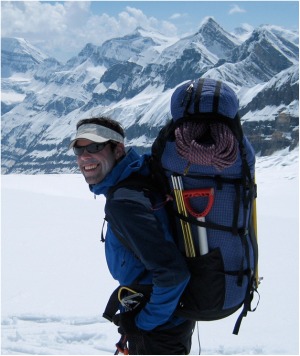
Dr. Zac Robinson, mountain historian and experienced mountaineer will be one of the leaders of this year's Outdoor Explorations course.
Students to experience the history and ecology of the mountains; learn about high-altitude physiology
This summer, from June 20 to July 29, University of Alberta students will have a rare opportunity to explore the cultural and physical landscapes of the Canada's Continental Divide in Jasper and Banff National Parks. It's all part of a unique outdoor explorations program that brings together studies in mountain history, parks management and ecology, human physiology at altitude, and mountaineering in an exciting, six-week, for-credit package.
"It's a well-rounded suite of courses that includes expertise in mountain studies from three different faculties," says physical education and recreation faculty professor, Zac Robinson, an alpine historian and experienced mountaineer. "The program, Outdoor Explorations, is built around three classes: a parks history class from the Faculty of Arts, an ecology course led by doctoral student and caribou biologist Simon Slater from the Faculty of Agriculture, Life, and Environmental Sciences, and a human physiology class, taught by exercise physiologist Alastair Hodges in the Faculty of Physical Education and Recreation."
"The three courses are taught over a five week period, which includes two extended backcountry expeditions," says Robinson. "One is a nine-day hiking trip to the Athabasca Pass in Jasper National Park. Historically speaking, this is an incredibly significant pass in that it was the route fur traders used to cross the Rockies for decades, long before the arrival of railways, parks, and highways."
It's a fitting destination as this year marks the 200th anniversary of the journey of one of Canada's most famous surveyors, explorers and mapmakers, David Thompson, who became the first Euro-Canadian to cross the Athabasca Pass as part of the North West Company's plan to open up the fur trade route to the Columbia River and to the Pacific Ocean.
"Our goal with the history component of Outdoor Explorations is to introduce students to the human history of the Rocky Mountain parks, specifically because it's so often that these landscapes are celebrated as wilderness areas, and rightly so, but in doing so we too often disavow or erase the whole human history that came there before these parks were created. It's so rich in histories - Aboriginal, European, Canadian; it's incredibly global - and to impart that perspective while we're actually there, in that place, creates an enriched learning experience not easily attained in the formal classroom," says Robinson.
Before heading out on their 100 km hike in Jasper National Park, students will learn about historic sites on outings with Parks Canada officials, historians, wildlife biologists and resource managers.
The ecology course at Jasper will be taught by Slater, who is researching conservation strategies for woodland caribou in Alberta. "Students will study how management tools, such as ecosystem-based management, are used in a national park setting to address current environmental issues," he says. "They'll also learn field identification skills for wildflowers, birds, and mammal tracks. Jasper National Park biologists will cover issues of woodland caribou conservation and fire management strategies as well as critically examining how to maintain ecological integrity in a national park."
After their hiking expedition, students will return to the U of A and begin a course on altitude and mountain physiology taught by Hodges, an outdoor enthusiast and longtime skier. "I want students to appreciate the significant physiological challenges facing the human body when it ascends to altitude and to provide some theoretical knowledge that will allow students to safely manage the challenges of high-altitude environments," says Hodges.
"They will perform calculations related to blood oxygen content and work rates, and take some simple measurements during field work at altitudes of up to about 3,500m. In addition, they'll learn the pathophysiology, and how to recognize the signs and symptoms, of the three main altitude-related illnesses: high-altitude pulmonary edema, high-altitude cerebral edema, and acute mountain sickness. We'll also discuss ways in which mountaineers can safely adapt their bodies to function at more significant altitudes," he adds.
The second expedition - a six-day mountaineering adventure - will be to the spectacular Wapta Icefields on the Continental Divide, which straddles both Banff and Yoho National Parks in Alberta and British Columbia. "Prior to heading up into the alpine with ACMG mountain guides, students will spend time in Banff working on independent projects in the archives of the Whyte Museum of the Canadian Rockies and with parks managers and officials. Banff National Park has different challenges than Jasper because of population density and the Trans-Canada Highway, for example," says Robinson, "so students will be introduced to a whole different set of park management challenges and techniques."
Robinson says that the ultimate goal of Outdoor Explorations is to foster a greater appreciation for the social, environmental, and physical complexities of the Rocky Mountains.
"Reading the journals of fur traders at the Athabasca Pass, actually feeling how your body responds to the altitude of the Divide, or walking along the trail with the experts responsible for the safekeeping of these places - it's a very different kind of learning than the one gained in a lab or classroom. There's a world of difference."
Outdoor Explorations 2011: Canada's Rocky Mountains runs from June 20 to July 29 2011.
Cost: Tuition, plus $1580
Number of participants: 10
No prior mountaineering or back-country travel experience needed; some basic camping experience would be useful.
Contact: Dr. Zac Robinson, zac.robinson@ualberta.ca